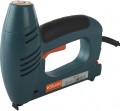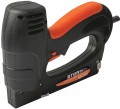Compatible staples
Staple models that the tool is compatible with.
Usually, quite specific options are indicated in this paragraph, so finding compatible consumables is not difficult. The specific dimensions of the fasteners should be specified according to the manufacturer's data — different brands use different markings.
Power consumption
The total power consumed by a mains-powered electric tool (see "Power Source"). It is considered the main criterion for assessing the overall capabilities of a particular model: more power leads to better performance. In addition, data on power consumption also allows you to estimate the load on the power grid or other power source; in some cases this is unnecessary.
Fuse
A device that protects the tool from being triggered at the wrong time.
Most often in a modern tool there are manual fuses in the form of a button or switch. Such a device blocks the release button or opens the power circuit; thus, when the
fuse is on, the tool will not work, no matter what the user does. This reduces the chance of fasteners "shooting" in the wrong direction and reduces the risk of personal injury and property damage.
Max. staple width
The largest width of staples (see Fastener Type) that the stapler can work with.
The width of the bracket is, roughly speaking, the distance between its legs. Different situations and types of work require different sizes of staples, and sometimes the width must be quite large. However, a staple that is too large simply will not fit into the store, not to mention the fact that the stapler can “shoot” it normally. Therefore, this limit cannot be exceeded, and if you plan to work with brackets, you should pay special attention to the maximum width when choosing.
Min. staple length
The smallest length of staples (see Fastener Type) that the stapler can work with.
The length in this case means the length of the leg — in other words, the depth to which the staple clogged "to the stop" penetrates into the material. Small staples do not require much power to drive, but the tool may not be designed for fasteners that are too short due to other parameters — for example, the design of the magazine. Therefore, for many models, this limitation is quite relevant, and in powerful professional models, the minimum length can be quite large — more than 20 mm.
Min. nail length
The shortest length of nails (see Fastener Type) that the stapler can handle.
The shorter the fastener, with the same thickness, the less effort is required to drive it, but a nail that is too short simply cannot stand under impact normally. Therefore, for many instruments, this restriction is directly indicated. It is worth paying attention to it first of all if you plan to work with small short nails.
Staples included
The number of staples supplied with the stapler.
Construction staplers can be supplied with a stock of fasteners (staples, nails, pins) — so that you can immediately start working without buying more consumables. And knowing the number of such parts, you can not only determine how much the initial stock will last, but also evaluate how profitable the purchase of this model will be compared to the model without consumables in the kit. For example, a relatively expensive model that comes with 1,000 staples can end up being a better value than a cheaper tool that doesn't come with any hardware.
Nails included
The number of nails supplied with the stapler.
Construction staplers can be supplied with a stock of fasteners (staples, nails, pins) — so that you can immediately start working without buying more consumables. And knowing the number of such parts, you can not only determine how much the initial stock will last, but also evaluate how profitable the purchase of this model will be compared to the model without consumables in the kit. For example, a relatively expensive model that comes with 200 nails, as a result may be more profitable than a cheaper tool that does not come with any fasteners.

